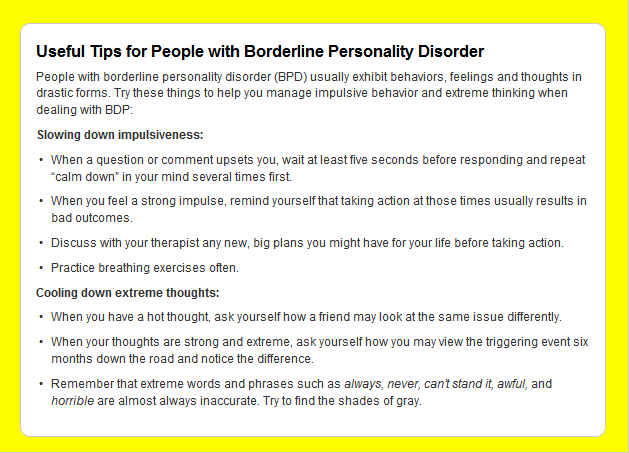- Messages
- 8,997
Understanding Borderline Suicides
http://www.tara4bpd.org/new-page-16/
BPD has a suicide rate of 10%. People with BPD are in constant emotional pain, pain so severe that it is often unbearable. Suicide attempts are often maladaptive efforts to make the pain stop and are not wishes to die. Unfortunately if someone doesn't come along and rescue them, they may succeed.
Suicide is a risk for people suffering with Borderline Personality Disorder (BPD) that must always be taken seriously. One in ten sufferers of BPD dies by suicide. The BPD suicide rate is similar to that for patients with Schizophrenia and major mood disorder. However, Schizophrenia makes up 1% of the general population while BPD affects 2-3 % of the general population. The rate of BPD suicide is therefore 2-3 times greater than that of schizophrenia. This sad outcome is not readily preventable and usually does not occur when the person is in treatment but when the patient does not recover and/or treatment has been unsuccessful. Many BPD deaths may be related to co-morbid conditions such as substance abuse, eating disorders, or impulsive sex leading to diseases such as AIDES.
The intensity of suicidality amongst patients with BPD varies over time. When people with BPD are acutely suicidal, they may appear to meet criteria for a major depressive episode. The affective or mood symptoms of people with BPD are different from those of people with mood disorders which may explain why they do not respond to antidepressants in the same way as people with depression. People with BPD seem to suffer from early onset dysthmia, a state of always being "blue."
People with this disorder are acutely sensitive, particularly to what they consider as painful. They do not have the ability or skills to tolerate this pain in the moment. Suicide attempts by people with BPD can best be understood as an impulsive response to severe emotional pain or a way of communicating distress. The object of this communication is usually a significant other, family member or a therapist. Suicide threats therefore indicate an attachment and involvement with others. Suicide completion may be associated with a loss of connection to others.
Unfortunately, hospitalizing someone with BPD after a suicide attempt is generally not effective and is no assurance that another attempt will not be made. Once hospitalization is introduced, suicide attempts and admissions can become repetitive with patients embarking on a "suicidal rescue career." If the person is suicidal after discharge, what has been accomplished by the hospitalization? When people with BPD are hospitalized for suicide attempts, they enter an environment that reinforces dependence, the very behaviors that therapy is trying to extinguish.
In addition, loved ones generally respond with attention and concern, resulting in a secondary gain that reinforces negative or harmful behaviors. Hospitalization may also provide social contact for persons with BPD who have poor social support. The BPD person generally receives more nursing care than other patients. Marsha Linehan, PhD, discourages the admission of BPD patients to hospitals after suicide attempts.
When a loved one has made a suicide attempt, it is excruciatingly difficult for families to accept that hospitalization can often be ineffective and counter-productive. Families feel it is their role to keep their children or spouses safe. How can not admitting them to a hospital in this frightening emergency situation be appropriate? A family we know has hospitalized their young daughter for 15 months because of an impulsive suicide attempt.
People with BPD need to learn to live and to tolerate their pain. The communicative function of suicidality needs to be understood by therapist and by family. It is a problem to be solved and should not be reinforced negatively. For this reason families must be informed of the rationale behind the treatment and be educated about management of the situation so that they can cooperate with therapy. It is extremely hard to tell a family member that they must endure their loved one's suicidality. Family relationships may becomes "coercive bondage" as the quality of the person's life becomes compromised by overzealous family concern. The family needs support, especially at these times. Ultimately, therapy must help people with BPD to tolerate their pain and find means to solve their problems. A patient with BPD states" When a therapist does not give the expected response to a suicide attempt or threat, they will be accused of not caring. But, what you are really doing is being cruel to be kind. When my doctor wouldn't hospitalize me, I accused him of not caring if I lived or died. He replied, referring to my cycle of repeated hospitalizations, "This is not life!" And, he was 100% right."
Sadly, some people with BPD people need to be suicidal. When they feel they have no power over their life, they retain the choice of death. They may remain suicidal until they feel can control their fate or their lives. The knowledge that they can choose to die allows them to go on living.
Linehan has recommends dealing with suicide as the first priority in a therapy session. The person cannot discuss other issues until this issue is dealt with, thus negatively reinforcing suicidal ideation. Clinicians and families need to respond to suicidal thoughts empathetically while avoiding overly anxious questions about intent. The following type of response may be most appropriate, "you must be feeling particularly upset to be thinking along these lines. Let's figure out what is making things worse and see if we can find a way of dealing with the problem."
The more we understand the suicide attempts of people with BPD, the better we will be able to prevent these unnecessary deaths.

http://www.tara4bpd.org/new-page-16/
BPD has a suicide rate of 10%. People with BPD are in constant emotional pain, pain so severe that it is often unbearable. Suicide attempts are often maladaptive efforts to make the pain stop and are not wishes to die. Unfortunately if someone doesn't come along and rescue them, they may succeed.
Suicide is a risk for people suffering with Borderline Personality Disorder (BPD) that must always be taken seriously. One in ten sufferers of BPD dies by suicide. The BPD suicide rate is similar to that for patients with Schizophrenia and major mood disorder. However, Schizophrenia makes up 1% of the general population while BPD affects 2-3 % of the general population. The rate of BPD suicide is therefore 2-3 times greater than that of schizophrenia. This sad outcome is not readily preventable and usually does not occur when the person is in treatment but when the patient does not recover and/or treatment has been unsuccessful. Many BPD deaths may be related to co-morbid conditions such as substance abuse, eating disorders, or impulsive sex leading to diseases such as AIDES.
The intensity of suicidality amongst patients with BPD varies over time. When people with BPD are acutely suicidal, they may appear to meet criteria for a major depressive episode. The affective or mood symptoms of people with BPD are different from those of people with mood disorders which may explain why they do not respond to antidepressants in the same way as people with depression. People with BPD seem to suffer from early onset dysthmia, a state of always being "blue."
People with this disorder are acutely sensitive, particularly to what they consider as painful. They do not have the ability or skills to tolerate this pain in the moment. Suicide attempts by people with BPD can best be understood as an impulsive response to severe emotional pain or a way of communicating distress. The object of this communication is usually a significant other, family member or a therapist. Suicide threats therefore indicate an attachment and involvement with others. Suicide completion may be associated with a loss of connection to others.
Unfortunately, hospitalizing someone with BPD after a suicide attempt is generally not effective and is no assurance that another attempt will not be made. Once hospitalization is introduced, suicide attempts and admissions can become repetitive with patients embarking on a "suicidal rescue career." If the person is suicidal after discharge, what has been accomplished by the hospitalization? When people with BPD are hospitalized for suicide attempts, they enter an environment that reinforces dependence, the very behaviors that therapy is trying to extinguish.
In addition, loved ones generally respond with attention and concern, resulting in a secondary gain that reinforces negative or harmful behaviors. Hospitalization may also provide social contact for persons with BPD who have poor social support. The BPD person generally receives more nursing care than other patients. Marsha Linehan, PhD, discourages the admission of BPD patients to hospitals after suicide attempts.
When a loved one has made a suicide attempt, it is excruciatingly difficult for families to accept that hospitalization can often be ineffective and counter-productive. Families feel it is their role to keep their children or spouses safe. How can not admitting them to a hospital in this frightening emergency situation be appropriate? A family we know has hospitalized their young daughter for 15 months because of an impulsive suicide attempt.
People with BPD need to learn to live and to tolerate their pain. The communicative function of suicidality needs to be understood by therapist and by family. It is a problem to be solved and should not be reinforced negatively. For this reason families must be informed of the rationale behind the treatment and be educated about management of the situation so that they can cooperate with therapy. It is extremely hard to tell a family member that they must endure their loved one's suicidality. Family relationships may becomes "coercive bondage" as the quality of the person's life becomes compromised by overzealous family concern. The family needs support, especially at these times. Ultimately, therapy must help people with BPD to tolerate their pain and find means to solve their problems. A patient with BPD states" When a therapist does not give the expected response to a suicide attempt or threat, they will be accused of not caring. But, what you are really doing is being cruel to be kind. When my doctor wouldn't hospitalize me, I accused him of not caring if I lived or died. He replied, referring to my cycle of repeated hospitalizations, "This is not life!" And, he was 100% right."
Sadly, some people with BPD people need to be suicidal. When they feel they have no power over their life, they retain the choice of death. They may remain suicidal until they feel can control their fate or their lives. The knowledge that they can choose to die allows them to go on living.
Linehan has recommends dealing with suicide as the first priority in a therapy session. The person cannot discuss other issues until this issue is dealt with, thus negatively reinforcing suicidal ideation. Clinicians and families need to respond to suicidal thoughts empathetically while avoiding overly anxious questions about intent. The following type of response may be most appropriate, "you must be feeling particularly upset to be thinking along these lines. Let's figure out what is making things worse and see if we can find a way of dealing with the problem."
The more we understand the suicide attempts of people with BPD, the better we will be able to prevent these unnecessary deaths.
















